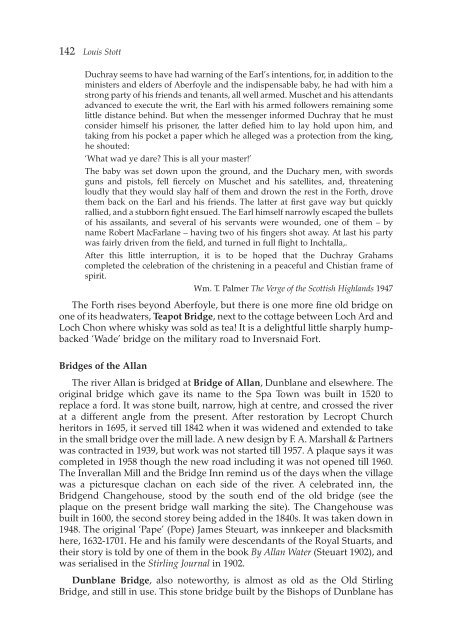the Forth Naturalist Historian - Forth Naturalist and Historian ...
the Forth Naturalist Historian - Forth Naturalist and Historian ...
the Forth Naturalist Historian - Forth Naturalist and Historian ...
Create successful ePaper yourself
Turn your PDF publications into a flip-book with our unique Google optimized e-Paper software.
142 Louis Stott<br />
Duchray seems to have had warning of <strong>the</strong> Earl’s intentions, for, in addition to <strong>the</strong><br />
ministers <strong>and</strong> elders of Aberfoyle <strong>and</strong> <strong>the</strong> indispensable baby, he had with him a<br />
strong party of his friends <strong>and</strong> tenants, all well armed. Muschet <strong>and</strong> his attendants<br />
advanced to execute <strong>the</strong> writ, <strong>the</strong> Earl with his armed followers remaining some<br />
little distance behind. But when <strong>the</strong> messenger informed Duchray that he must<br />
consider himself his prisoner, <strong>the</strong> latter defied him to lay hold upon him, <strong>and</strong><br />
taking from his pocket a paper which he alleged was a protection from <strong>the</strong> king,<br />
he shouted:<br />
‘What wad ye dare? This is all your master!’<br />
The baby was set down upon <strong>the</strong> ground, <strong>and</strong> <strong>the</strong> Duchary men, with swords<br />
guns <strong>and</strong> pistols, fell fiercely on Muschet <strong>and</strong> his satellites, <strong>and</strong>, threatening<br />
loudly that <strong>the</strong>y would slay half of <strong>the</strong>m <strong>and</strong> drown <strong>the</strong> rest in <strong>the</strong> <strong>Forth</strong>, drove<br />
<strong>the</strong>m back on <strong>the</strong> Earl <strong>and</strong> his friends. The latter at first gave way but quickly<br />
rallied, <strong>and</strong> a stubborn fight ensued. The Earl himself narrowly escaped <strong>the</strong> bullets<br />
of his assailants, <strong>and</strong> several of his servants were wounded, one of <strong>the</strong>m – by<br />
name Robert MacFarlane – having two of his fingers shot away. At last his party<br />
was fairly driven from <strong>the</strong> field, <strong>and</strong> turned in full flight to Inchtalla,.<br />
After this little interruption, it is to be hoped that <strong>the</strong> Duchray Grahams<br />
completed <strong>the</strong> celebration of <strong>the</strong> christening in a peaceful <strong>and</strong> Chistian frame of<br />
spirit.<br />
Wm. T. Palmer The Verge of <strong>the</strong> Scottish Highl<strong>and</strong>s 1947<br />
The <strong>Forth</strong> rises beyond Aberfoyle, but <strong>the</strong>re is one more fine old bridge on<br />
one of its headwaters, Teapot Bridge, next to <strong>the</strong> cottage between Loch Ard <strong>and</strong><br />
Loch Chon where whisky was sold as tea! It is a delightful little sharply humpbacked<br />
‘Wade’ bridge on <strong>the</strong> military road to Inversnaid Fort.<br />
Bridges of <strong>the</strong> Allan<br />
The river Allan is bridged at Bridge of Allan, Dunblane <strong>and</strong> elsewhere. The<br />
original bridge which gave its name to <strong>the</strong> Spa Town was built in 1520 to<br />
replace a ford. It was stone built, narrow, high at centre, <strong>and</strong> crossed <strong>the</strong> river<br />
at a different angle from <strong>the</strong> present. After restoration by Lecropt Church<br />
heritors in 1695, it served till 1842 when it was widened <strong>and</strong> extended to take<br />
in <strong>the</strong> small bridge over <strong>the</strong> mill lade. A new design by F. A. Marshall & Partners<br />
was contracted in 1939, but work was not started till 1957. A plaque says it was<br />
completed in 1958 though <strong>the</strong> new road including it was not opened till 1960.<br />
The Inverallan Mill <strong>and</strong> <strong>the</strong> Bridge Inn remind us of <strong>the</strong> days when <strong>the</strong> village<br />
was a picturesque clachan on each side of <strong>the</strong> river. A celebrated inn, <strong>the</strong><br />
Bridgend Changehouse, stood by <strong>the</strong> south end of <strong>the</strong> old bridge (see <strong>the</strong><br />
plaque on <strong>the</strong> present bridge wall marking <strong>the</strong> site). The Changehouse was<br />
built in 1600, <strong>the</strong> second storey being added in <strong>the</strong> 1840s. It was taken down in<br />
1948. The original ‘Pape’ (Pope) James Steuart, was innkeeper <strong>and</strong> blacksmith<br />
here, 1632-1701. He <strong>and</strong> his family were descendants of <strong>the</strong> Royal Stuarts, <strong>and</strong><br />
<strong>the</strong>ir story is told by one of <strong>the</strong>m in <strong>the</strong> book By Allan Water (Steuart 1902), <strong>and</strong><br />
was serialised in <strong>the</strong> Stirling Journal in 1902.<br />
Dunblane Bridge, also noteworthy, is almost as old as <strong>the</strong> Old Stirling<br />
Bridge, <strong>and</strong> still in use. This stone bridge built by <strong>the</strong> Bishops of Dunblane has



